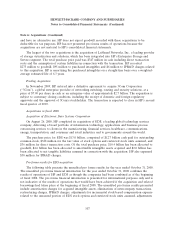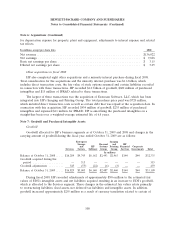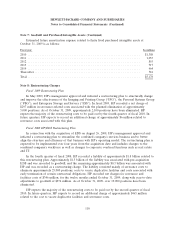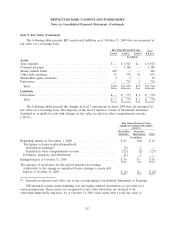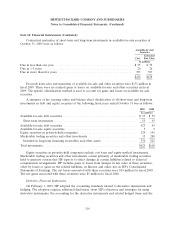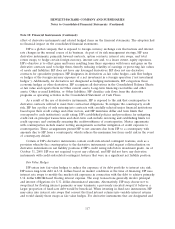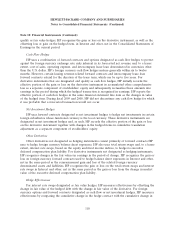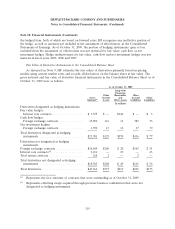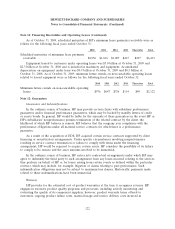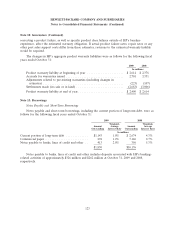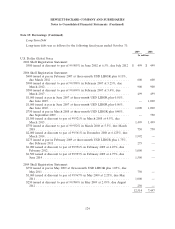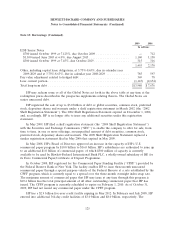HP 2009 Annual Report Download - page 124
Download and view the complete annual report
Please find page 124 of the 2009 HP annual report below. You can navigate through the pages in the report by either clicking on the pages listed below, or by using the keyword search tool below to find specific information within the annual report.HEWLETT-PACKARD COMPANY AND SUBSIDIARIES
Notes to Consolidated Financial Statements (Continued)
Note 10: Financial Instruments (Continued)
effect of derivative instruments and related hedged items on the financial statements. The adoption had
no financial impact on the consolidated financial statements.
HP is a global company that is exposed to foreign currency exchange rate fluctuations and interest
rate changes in the normal course of its business. As part of its risk management strategy, HP uses
derivative instruments, primarily forward contracts, option contracts, interest rate swaps, and total
return swaps, to hedge certain foreign currency, interest rate and, to a lesser extent, equity exposures.
HP’s objective is to offset gains and losses resulting from these exposures with losses and gains on the
derivative contracts used to hedge them, thereby reducing volatility of earnings or protecting fair values
of assets and liabilities. HP does not have any leveraged derivatives. HP does not use derivative
contracts for speculative purposes. HP designates its derivatives as fair value hedges, cash flow hedges
or hedges of the foreign currency exposure of a net investment in a foreign operation (‘‘net investment
hedges’’). Additionally, for derivatives not designated as hedging instruments, HP categorizes those
economic hedges as other derivatives. HP recognizes all derivatives in the Consolidated Balance Sheets
at fair value and reports them in Other current assets, Long-term financing receivables and other
assets, Other accrued liabilities, or Other liabilities. HP classifies cash flows from the derivative
programs as operating activities in the Consolidated Statement of Cash Flows.
As a result of the use of derivative instruments, HP is exposed to the risk that counterparties to
derivative contracts will fail to meet their contractual obligations. To mitigate the counterparty credit
risk, HP has a policy of only entering into contracts with carefully selected major financial institutions
based upon their credit ratings and other factors, and HP maintains dollar and term limits that
correspond to each institution’s credit rating. HP’s established policies and procedures for mitigating
credit risk on principal transactions and short-term cash include reviewing and establishing limits for
credit exposure and continually assessing the creditworthiness of counterparties. Master agreements
with counterparties include master netting arrangements as further mitigation of credit exposure to
counterparties. These arrangements permit HP to net amounts due from HP to a counterparty with
amounts due to HP from a counterparty, which reduces the maximum loss from credit risk in the event
of counterparty default.
Certain of HP’s derivative instruments contain credit-risk-related contingent features, such as a
provision whereby the counterparties to the derivative instruments could request collateralization on
derivative instruments in net liability positions if HP’s credit rating falls below investment grade. As of
October 31, 2009, HP was not required to post any collateral, and HP did not have any derivative
instruments with credit-risk-related contingent features that were in a significant net liability position.
Fair Value Hedges
HP enters into fair value hedges to reduce the exposure of its debt portfolio to interest rate risk.
HP issues long-term debt in U.S. dollars based on market conditions at the time of financing. HP uses
interest rate swaps to modify the market risk exposures in connection with the debt to achieve primarily
U.S. dollar LIBOR-based floating interest expense. The swap transactions generally involve principal
and interest obligations for U.S. dollar-denominated amounts. Alternatively, HP may choose not to
swap fixed for floating interest payments or may terminate a previously executed swap if it believes a
larger proportion of fixed-rate debt would be beneficial. When investing in fixed-rate instruments, HP
may enter into interest rate swaps that convert the fixed interest returns into variable interest returns
and would classify these swaps as fair value hedges. For derivative instruments that are designated and
117


